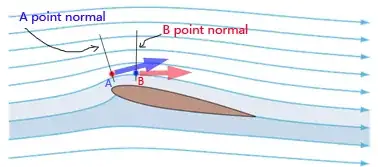I am studying about the lift generated by a fluid flowing on a surface. In the case of an airfoil I have seen that there are various ways to explain it, you can use for example:
the third law of newton: the wing exerts a downward force on the air and therefore the air exerts an equal force but upwards;
the preservation of the mass: after the point of the wing in which the flow separates, we will have flow lines (streamtubes) closer above the wing and more spaced under the wing; assuming that the air is not compressible, since the flow rate is constant, this translates into higher air velocity above the wing and lower under the wing, and therefore lower pressure on the upper surface and higher pressure on the lower surface (Bernoulli's principle).
In the latter approach, however, I did not understand why the streamtubes above/below the wing change size. In essence, none of the explanations found seem to clarify the real reason for the change of air speed above (speed increases) and below (speed decreases) the wing.
Since the lift is generated even if the wing has a symmetrical profile, it seems to me that having a higher profile more curved than the lower profile is not the only characteristic at the base of the lift but serves to increase its efficiency.
So, taking the case of a symmetrical airfoil with a certain "positive" angle of attack (i.e. the leading edge is higher than the trailing edge), I think that the most important thing to understand the lift is that the point where the flow separates into two flow lines (one that passes over the wing, one that passes under the wing) does not coincide with the leading edge. But I do not understand the implications of this.
Summing up what I do not understand is what the difference in the air speed above and below the wing is due to. Rather than in the explanation by formulas I am more interested in a physical explanation (what pratically happens to the fluid).
